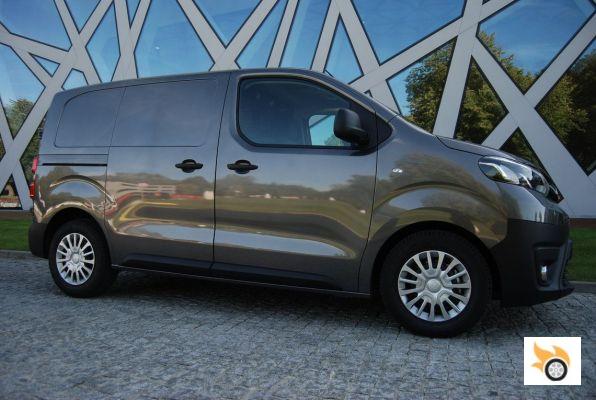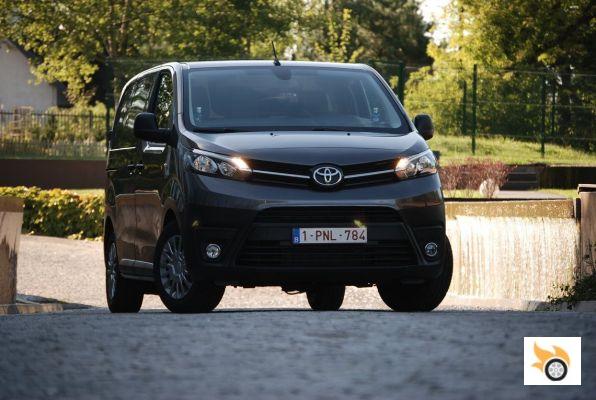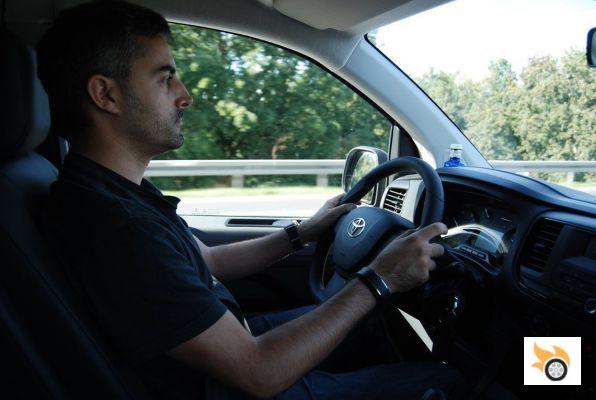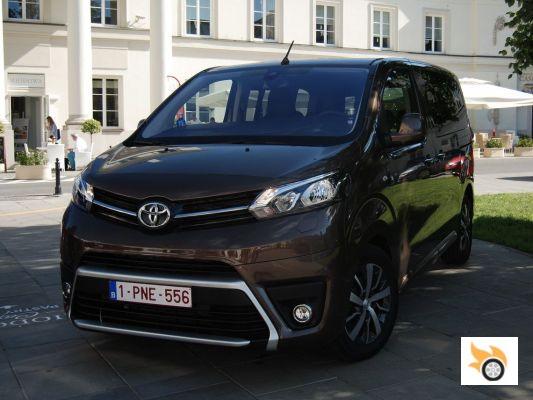Toyota took advantage of Fiat's non-renewal of its medium-duty van (MDV) agreement with PSA, an agreement dating back to the 1970s, to enter this segment with a much more modest investment. The French welcomed the Japanese with open arms, and the know-how of these manufacturers came together to create a new generation of vans. Almost all the comments made in this review apply to the Jumpy and Expert, unless otherwise stated.
Three lengths are available: compact (L0 or 4.6 m), short (L1 or 4.9 m) and long (L2 or 5.3 m); two wheelbases (2,925 mm for L0 and 3,275 mm for L1 and L2), one body height (H1), two suspension heights and width common to all. In the case of Proace, the outstanding novelty is that it has passenger versions, Proace Verso, since the model that arrived in the last breath in 2012 was only available as industrial. The compact version is undoubtedly one of the most interesting, because in 4.6 m you can fit up to 5.1 m³ or nine passengers, it is an alternative to the "maxi" derivatives of passenger cars, such as Caddy Maxi or Kangoo Maxi. No other van in the MDV segment is shorter.
High-roof versions (H2) are still under development.

As for the engines, they are all diesel and of PSA origin, with selective catalytic reduction (SCR) to reduce pollution. Every 15,000 kilometres or so, AdBlue will have to be refuelled in an intake that is exposed when the driver's door is opened; it uses about 0.15 litres/100 km. If the 22.5-litre urea tank runs out, the engine won't start, but there will be plenty of warning. With the medium displacement (1.6) you can choose 95 or 115 hp, and with the medium-high (2.0) the powers are 120, 150 and 180 hp. It is ruled out that there will be a petrol or diesel hybrid version in this generation.
The scheduled maintenance intervals are 40,000 kilometers or two years, which can be reduced slightly if the use is more intensive. There is an "all-inclusive" option, which for 15 euros a month allows you to waive maintenance costs, including wear parts, but not tyres. However, this means going to Toyota workshops, although any authorised Citroën or Peugeot workshop can service them, as the mechanics' training is the same.
Taxi drivers may opt for the Proace Verso Shuttle, which has not yet been approved for this purpose. As for conversions for people with reduced mobility (PRM), they are planned, but have not been developed. In October, the compact van and Verso versions will arrive in dealerships, but we will have to wait until December to order the L2, platform cab and Verso VIP (top of the range). We were able to test two compacts, the lower power (1.6 95 hp) and the intermediate (2.0 150 hp).
There will be no all-wheel drive versions, but it has an interesting improvement, the Toyota Traction Select, which is nothing more than the intelligent traction control developed by PSA (Intelligent Grip), which manages more effectively the front axle in low grip conditions such as mud, sand or snow. We explained the rationale behind this system in a previous article, and it conditions the choice of 17″ tyres. Unlike Jumpy and Expert, Proace offers this equipment as standard on some versions, the French ones always offer it as an extra.
It can be ordered with the suspension raised by 25 mm, to make it easier to negotiate difficult terrain (such as building sites).
In terms of active safety, the improvement is substantial by incorporating some equipment that increases tolerance to driver error. Toyota Safety Sense, developed by PSA under instructions from Toyota, can read traffic signs and display them on the dashboard, warn of an imminent collision, warn of unintentional lane departure, brake automatically in the event of pedestrians or objects, warn a van driver who is falling asleep, etc. The system is based on a video camera, rear-view mirror sensors and a front microwave radar. As we have seen, the PSA-Toyota trio of "furgos" is more complete than ever.
Last but not least, the technological aspects. The top of the range infotainment system brings these vans into the modern era, and the fleet management system is a big brother that will allow employers to keep a close eye on the little guys. For a modest monthly fee, you'll be able to know how they drive (do they brake too much? do they wear out? are they on a stretch?), where they are, the mechanical condition of each unit, if they're cold-stomping... It's a perverse and brilliant invention at the same time.
Industrial range
Depending on the needs of the person, it can be pure van, double cab, platform cab (for special bodywork) and combi/mixed. In the second equipment level of the cargo version there is a curious feature, called Smart Cargo, which is a hatch under the co-driver's feet, which can be opened. The seat can be folded on itself leaving a gap, allowing an object to be placed 1.16 meters longer, that is, 3.3 meters in plan skewer (across the length). In this range there are always three front seats.
In the compact version two Europallets can be accommodated, in the medium and long version three can be accommodated.
The minimum loading volume is 4.6 m³ for the van without Smart Cargo or using the front seats, with short wheelbase and short length. The medium can hold 5.3 m³ and the long 6.1 m³, which can be extended to 5.8 and 6.6 m³ if the Smart Cargo conversion is used. On the other hand, the long one has 200 kg more load capacity. The side doors are always sliding, and there is a choice of three types of tailgate: double leaf at 180º, double leaf at 250º or tailgate with glass. For the Spanish market, the load versions will have an opaque rear to reduce the temptation for those who want to get in on the act.
Within the versions for workers, when it comes to carrying more people, are the Combi Business and Combi Comfort. The latter has a better acoustic treatment, more suitable for longer distance journeys, and is also better equipped. Any van comes with its air conditioning, Bluetooth and USB radio, cruise control and speed limiter, driver's armrest and other amenities that are a must nowadays. Keep in mind that the front climate control may not be enough to keep those in the back comfortable on hot or cold days.
Passenger range
The PSA equivalents are the Citroën Spacetourer and Peugeot Traveller. The Proace Verso is available in three levels: Shuttle (for taxi drivers or VTC), Family (alternative to MPV) and VIP (for executive transfers). Due to the tax system we have in Spain, they are 4.75% more expensive when registered as a car, but are interesting for freelancers and companies that opt for the industrial mode; yes, up to 100 km / h and annual ITV.
There is a significant improvement in the interiors, obviously, as it is more of a leisure/work vehicle than just a work vehicle. Depending on how much you want to spend you can have two-zone or three-zone climate control, start/stop button, sunroof, folding table, six to eight seats (only two in the first row), leather upholstery, "hands-free" opening doors by passing a foot on the floor, second row in the opposite direction to the march, and so on. The first row has two seats, between which there is nothing, neither a chest nor a floor rack.
The passenger versions have rails to move the seats, the Proace vans have fixed position anchors.
It has to be said that with three rows of seats and the short length/bathroom, luggage space is quite modest at 224 litres, like a B-segment car. The medium increases to 603 litres, and the long one to 989 litres. That's up to seat height, but squeezing up to the roof and in five-seat mode the cargo volume ranges from two to three cubic meters. No European SUV can rival those figures. Another curious detail, the 2.0 D-4D 120 hp is not available for passenger versions, only 1.6 95, 1.6 115, 2.0 150 and 2.0 180. By the way, the 1.6 115 hp is more fuel efficient than the 95 hp, thanks to the sixth gear.
Interior at a glance
No matter which version we're talking about, the driving position is great in terms of ergonomics and storage space, but the transmission tunnel is still very bulky. If it were up to me, I'd put an American-style automatic gearbox (on the steering column) and clear that gap. As the steering wheel is adjustable in height and depth, you can reach the controls further to the right without being uncomfortable, leaving the handbrake always to the right of the driver, when before it was placed in its place: to the left.
There's room for just about everything
All versions have an upper glovebox on the right side, but the lower part can be open or covered. In that area you can plug in a 12-volt device or a sound source with a 3.5 mm auxiliary jack. The USB is in the middle, very visible. Almost all plastics are very hard, but the quality and fit are convincing even when driving over bumps. The feeling of touching the controls is very PSA, and the big slackness of the old gearboxes remains in the memory.
From the previous generation I accumulated more than 2,500 kilometers with Scudo and Jumpy, and I felt in a more sophisticated vehicle, much closer to the world of passenger cars or minivans of large size, like the one that jumps from a car to another two generations more modern. The passenger versions are a little more pleasant due to a superior soundproofing and because the suspension is designed for that use, not to load the beast. The improvement is unquestionable.

Driving impressions
First I tested the less powerful version, with 95 hp. Although the technical sheet declares 0-100 km / h in an eternity and a half (15.9 seconds) the engine seemed to me sufficiently spirited and agile, yes, with only two occupants and with an empty box. It recovers with a lot of dignity, yes, at 120 km/h the engine is already very revved, maybe it could use a sixth gear. Compared to the previous 2.0 D-4D/HDi 120 hp 2.0 D-4D/HDi, it feels less sluggish at low revs. With hardly any highway driving and with an economic driving I averaged 5.1 l/100 km.
The 150 hp engine is very comfortable, has a remarkable reserve of power and reaches 100 km / h in 11 seconds. It has a pleasant feel, it is noticeable that the Euro 6 engines are noticeably smoother than the Euro 4 I tested back in the day. The driving sensation is that of a minivan. I didn't get as "sporty" a feeling as I did with the 140 hp Transporter 2.0 TDI, but it's certainly close to the benchmark in the MDV segment. It uses very little more, 6.1 l/100 km according to the computer. With the previous 2.0 Multijet/HDi the most normal was 7.4-7.5 l/100 km.
I would like to highlight the smoothness of the Stop&Start when stopping and starting, a highlight for PSA.
Except for the basic radio screen, a bit outdated (white monochrome), you get the feeling of driving a very modern car. I have to complain about the width of the rear-view mirrors (I found them narrow), about the limited cooling capacity of the A/C in the compact van - with 25 degrees outside - or about how bouncy the cargo version is when it's empty (this is quite normal). By the way, I found the power steering a bit indirect when making tight turns, you have to move your arms briskly.

The characteristics of the route, two-way roads linking one Polish village to another, prevented the tested units from being in any trouble; moreover, the terrain was smooth. Later we may do another test similar to that of the Transporter, both in mountain passes on fire, as well as loaded to the brim. For a first contact, the impressions are very positive, especially knowing the previous generation.
I know I'm repeating myself more than garlic, but I'll say it again: it's impressive how the light commercial category is improving in a very short time, any professional will be able to agree with me. In a few years they have gone from being uncomfortable, very slow, unsafe and clumsy to being alternatives to SUVs or minivans. When you work several hours a day in a light VI, all this is tremendously appreciated.
In this generation there is no Italian touch, because Fiat has not collaborated; they preferred to ally with Renault, Nissan and Opel, and launch the Fiat Talento. Toyota has done good business. It now has a large industrial and MPV that it can offer in all its dealerships, and intends to differentiate itself from Citroën and Peugeot through after-sales. MDV vans are ~15% of the Spanish light VI market, where more combis/passenger vans are registered than vans, as there are a lot of freelancers out there who also want to make recreational use of their work vehicle.
It's not a huge pie, but the VIs are recovering to a more impressive extent, as the crisis shrunk the Spanish market to an alarming extent. Whatever the government and macroeconomic indicators say, the fact is that this is starting to move, and it's a good indicator of how the economy is doing. And it should move more, if it is "dangerous" a fleet of aging cars, not to mention the "fregonetas" that go around without ABS, no airbags, no stability control, and fall apart.
Toyota and PSA want to eat ground to their rivals MDV - as Transporter - but also CDV as Doblò, Kangoo, Citan and company in their elongated versions. The high roof range (H2) is yet to arrive, so they can compete with some versions of the big ones (HDV) such as Ducato, Movano, Daily, etc.. The Franco-Japanese trio does not fall short in versatility or breadth of range.
However, they are left out of some leagues: transformations for the disabled, there are no natural gas or electric versions, no automatic versions, nor have they set foot in the very juicy sector of the transformations in motorhome. Ask Ford, Mercedes-Benz, Renault or Volkswagen how they are doing in that business... They are not exactly making money with those who spend 50,000-60,000 euros (or more) in a commercial vehicle derivative...


























